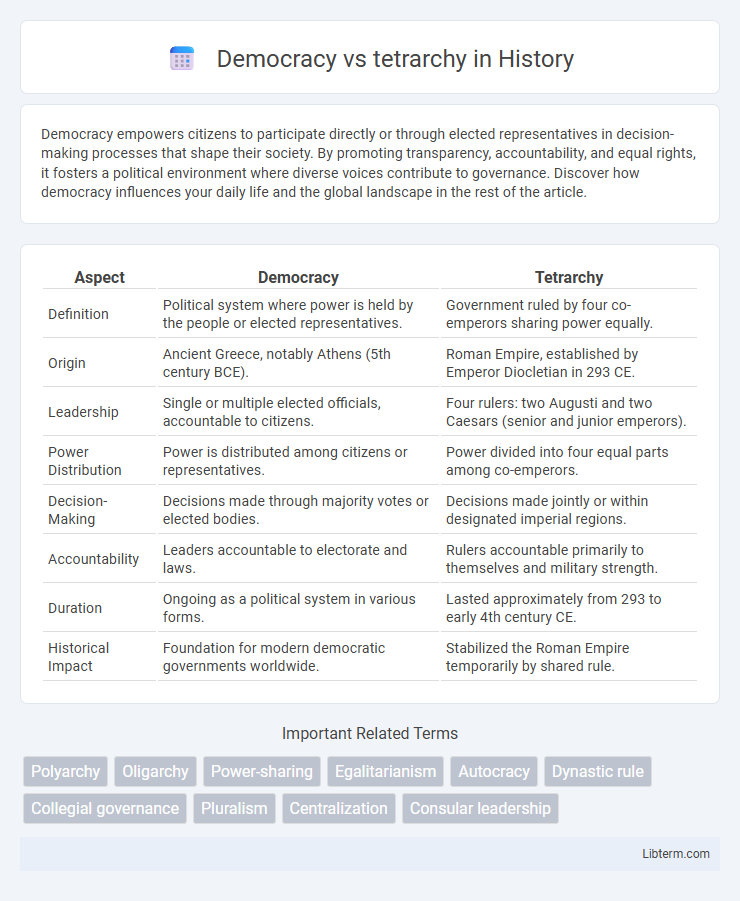Democracy empowers citizens to participate directly or through elected representatives in decision-making processes that shape their society. By promoting transparency, accountability, and equal rights, it fosters a political environment where diverse voices contribute to governance. Discover how democracy influences your daily life and the global landscape in the rest of the article.
Table of Comparison
| Aspect | Democracy | Tetrarchy |
|---|---|---|
| Definition | Political system where power is held by the people or elected representatives. | Government ruled by four co-emperors sharing power equally. |
| Origin | Ancient Greece, notably Athens (5th century BCE). | Roman Empire, established by Emperor Diocletian in 293 CE. |
| Leadership | Single or multiple elected officials, accountable to citizens. | Four rulers: two Augusti and two Caesars (senior and junior emperors). |
| Power Distribution | Power is distributed among citizens or representatives. | Power divided into four equal parts among co-emperors. |
| Decision-Making | Decisions made through majority votes or elected bodies. | Decisions made jointly or within designated imperial regions. |
| Accountability | Leaders accountable to electorate and laws. | Rulers accountable primarily to themselves and military strength. |
| Duration | Ongoing as a political system in various forms. | Lasted approximately from 293 to early 4th century CE. |
| Historical Impact | Foundation for modern democratic governments worldwide. | Stabilized the Roman Empire temporarily by shared rule. |
Introduction: Defining Democracy and Tetrarchy
Democracy is a system of government where power is vested in the people, typically through elected representatives, ensuring collective decision-making and individual liberties. Tetrarchy, established by Roman Emperor Diocletian in 293 AD, divides authority among four rulers to maintain administrative efficiency and political stability across vast territories. Understanding these contrasting governance models highlights the evolution from shared popular sovereignty to segmented imperial control.
Historical Origins of Democracy and Tetrarchy
Democracy originated in ancient Athens around the 5th century BCE, characterized by direct participation of citizens in decision-making processes. The tetrarchy was established by Roman Emperor Diocletian in 293 CE as a system to divide imperial power among four rulers to improve administrative efficiency and control. These distinct historical origins reflect democracy's roots in citizen empowerment versus the tetrarchy's centralized autocratic governance.
Core Principles: People’s Rule vs. Collective Leadership
Democracy centers on the principle of people's rule, where sovereignty resides with the citizens who exercise power through voting and representation. Tetrarchy embodies collective leadership, dividing power among four rulers to balance authority and prevent autocracy. This contrast highlights individual participation in governance versus shared executive control for stability and efficiency.
Decision-Making Structures: Majoritarian vs. Power-sharing
Democracy features a majoritarian decision-making structure where policies are determined by the majority of elected representatives or citizens, ensuring that the preference of the larger group prevails. In contrast, a tetrarchy employs a power-sharing model that divides authority among four rulers, promoting balance and preventing dominance by a single individual. This structure encourages consensus and collaboration among the co-rulers, reflecting a more distributed approach to governance compared to the majoritarian principle in democracy.
Legitimacy and Authority: Electoral Mandate vs. Elite Consensus
Democracy derives legitimacy through an electoral mandate, where authority is granted by the popular vote of citizens, ensuring government accountability and responsiveness to public preferences. In contrast, tetrarchy relies on elite consensus among a small group of rulers, concentrating authority within a limited circle that legitimizes power through mutual agreement rather than mass participation. The democratic model prioritizes broad-based legitimacy anchored in citizen endorsement, whereas tetrarchy emphasizes stability and order maintained by elite negotiation and shared control.
Stability and Flexibility in Governance
Democracy offers flexibility in governance through regular elections and citizen participation, allowing adaptation to social changes and diverse interests. Tetrarchy, a form of power-sharing among four rulers, provides stability by distributing authority and preventing concentration of power but tends to resist rapid change due to its rigid structure. The balance between democracy's dynamic responsiveness and tetrarchy's controlled stability highlights contrasting approaches to maintaining effective governance.
Representation and Citizen Participation
Democracy emphasizes direct citizen participation and equal representation through voting and public deliberation, ensuring leaders reflect the population's will. Tetrarchy divides power among four rulers, limiting broad citizen involvement and concentrating decision-making within a small elite. This system reduces individual political agency compared to democratic models prioritizing widespread representation and participation.
Challenges and Criticisms of Each System
Democracy faces challenges such as the risk of majority tyranny, slow decision-making processes, and susceptibility to misinformation impacting voter choices. Tetrarchy encounters criticisms related to power fragmentation, potential conflicts between co-rulers, and difficulties in maintaining unified governance and consistent policies. Both systems struggle with balancing effective leadership and representation while addressing internal power dynamics and public accountability.
Modern Examples and Lasting Impacts
Modern democracies such as the United States and Germany emphasize representative governance, individual rights, and regular free elections, contributing to political stability and social progress. In contrast, contemporary examples of tetrarchy-like systems are rare, but power-sharing arrangements like the Swiss Federal Council demonstrate a plural executive model that reduces centralization and fosters consensus. The lasting impact of democracy includes widespread institutional accountability and civic participation, whereas tetrarchic principles influence conflict resolution frameworks and multi-leadership governance in coalition governments.
Conclusion: Lessons from Democracy and Tetrarchy
Democracy offers lessons in citizen participation, accountability, and decentralized power that promote political stability and individual freedoms. The tetrarchy demonstrates the effectiveness of power-sharing and administrative division in managing vast empires but risks fragmentation and authoritarian control. Combining democratic inclusivity with structured governance from the tetrarchy can inform modern political systems seeking balance between representation and efficiency.
Democracy Infographic

 libterm.com
libterm.com